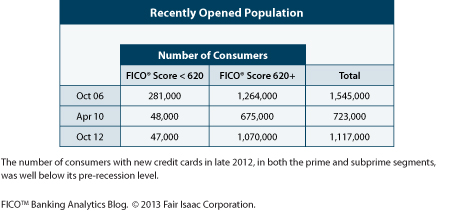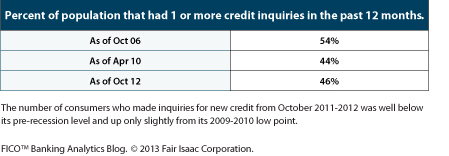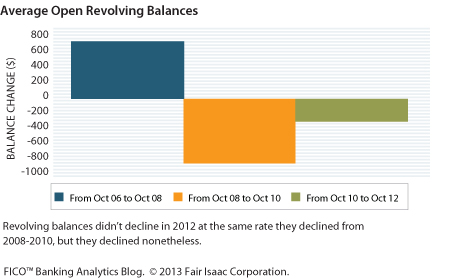The Great Consumer Releveraging of 2013 … or Not
As I’ve discussed previously, bankers seem to think years of deleveraging by US consumers will finally end in 2013. In our last quarterly survey of bankers, 61% of respondents…

As I’ve discussed previously, bankers seem to think years of deleveraging by US consumers will finally end in 2013. In our last quarterly survey of bankers, 61% of respondents said consumers will be applying for more new credit and trying to bump up the limits on existing credit accounts over the next six months. Moreover, 59% of respondents expected credit card balances to increase over the next six months.
There’s just one catch to this notion—we don’t yet have enough data to support it. As the saying goes, it takes two to tango. While banks may be in a more giving mood today than they were at the depth of the recession, the data in the following three charts indicates that consumers haven’t yet taken the plunge en masse to open new credit.
And lest anyone assume this lack of new account openings is due to overly cautious lenders, it is also the case that inquiries by consumers for new credit fell precipitously during this period.
So where are we today? It appears that lenders are providing more new credit than was the case in 2010. However, the numbers from late 2012 say we’re not yet at the end of the deleveraging period. In fact, the average revolving balance was down from $4660 in 2006 to $4060 in 2012.
Which way will consumer credit usage go in 2013? Bankers seems to think that when the data for 2013 is available, we’ll see that consumers are finally back to (or at least approaching) their old spending habits.
We’ll have to wait for the actual data to know whether this is true. But I know the number of consumers without an open credit card at the end of 2012 was up more than 40% from 2006. Unless that trend begins to reverse itself, it’s hard to see how consumer indebtedness will reach pre-recession levels in the near future.
Popular Posts

Business and IT Alignment is Critical to Your AI Success
These are the five pillars that can unite business and IT goals and convert artificial intelligence into measurable value — fast
Read more
FICO® Score 10T Decisively Beats VantageScore 4.0 on Predictability
An analysis by FICO data scientists has found that FICO Score 10T significantly outperforms VantageScore 4.0 in mortgage origination predictive power.
Read more
Average U.S. FICO Score at 717 as More Consumers Face Financial Headwinds
Outlier or Start of a New Credit Score Trend?
Read moreTake the next step
Connect with FICO for answers to all your product and solution questions. Interested in becoming a business partner? Contact us to learn more. We look forward to hearing from you.



